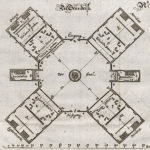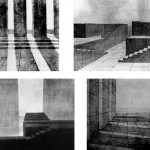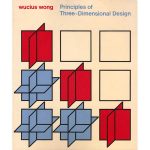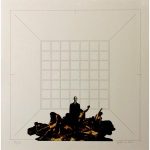
Born in 1872 as illegitimate son of an architect and of the revered actress Dame Ellen Terry, Edward Gordon Craig was raised as an actor in the company of Sir Henry Irving, only to discover later his true vocation as a theatrical designer.
Similar to Adolphe Appia in his struggle against the reproduction of reality, Craig envisaged scenic environments designed to appel to the emotion through visual suggestion, evocation and symbolist aesthetics. Without actually meeting until 1914, the two shared and promoted similar ideas on the use of light and stage space: Craig used to lit the stage from above, rather than adopting the traditional foot lighting. Colour and shadow played a strong role in his sets: “Under the play of this light, the background becomes a deep shimmering blue, apparently almost translucent, upon which the green and purple make a harmony of great richness.” (Craig in Bablet, 1981).
His most important scenographic concept was the idea of using neutral, mobile, non-representational screens as a staging device: a system of hinged and fixed flats quickly arrangeable for internal and external scenes. His stage sets were more about a strong sense of mood and atmosphere than naturalism. Movement, action, words, colour and rhytm was used a strong means of conceptualization, combining in a dynamic form.
Early Italian painters and architects, such as Duccio and Sebastiano Serlio, as well as the Japanese theatre, influenced Craig to pursue a “total” theatre, with an emphasis on dance and colour symbolism. Another strong influence came from his mother’s lover, director Henry Irving, that Craig used to idolise and quote in his writings on stage design, masks, marionettes and lighting.
Craig was particularly interested in masks, as “paramount weapon of dramatic expression“. He believed in a theatre that asks for human face in order to take us beyond reality: the role of the mask is to carry conviction and becoming part of the actor who is wearing it.
As an engraver and classical artist, Craig found inspiration in puppets: he asserted that the director was “the true artist of the theatre” and, controversially, suggested viewing actors as no more important than marionettes. In fact, he believed the marionettes to be the only true actors, loyal interpreter with the virtues of silence and obedience: “There is only one actor – nay one man who has the soul of the dramatic poet, and who has ever served as the true and loyal interpreter of the poet,” he proclaimed, and “this is the marionette.”
All of his life Craig promoted a visual theatre (he always argued audiences go to see, rather than hear, plays). Design elements have to function as symbols and communicate deeper meanings, rather than simply reflecting the real world.






























Further reading:
On the Art of Theatre, by Edward Gordon Craig (on archive.org)
Edwart Gordon Craig Presentation
EGC on Wikipedia
Moscow Art Theatre production of Hamlet
“An Idealist”: The Legacy of Edward Gordon Craig’s Formative Productions, 1900-1903





[…] “Under the play of this light, the background becomes a deep shimmering blue, apparently almost translucent, upon which the green and purple make a harmony of great richness.” (Craig in Bablet, 1981) “His most important scenographic concept was the idea of using neutral, mobile, non-representational screens as a staging device: a system of hinged and fixed flats quickly arrangeable for internal and external scenes. His stage sets were more about a strong sense of mood and atmosphere than naturalism. Movement, action, words, colour and rhytm was used a strong means of conceptualization, combining in a dynamic form. ” –http://socks-studio.com/2014/02/15/to-transcend-reality-and-function-as-symbol-stage-design-of-edwar… […]